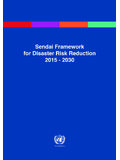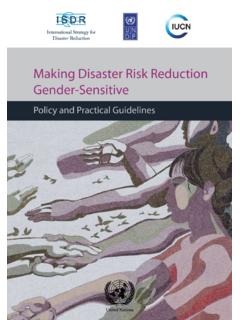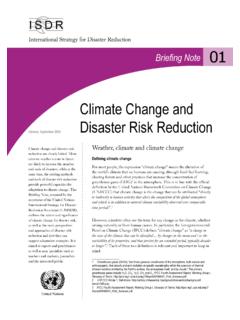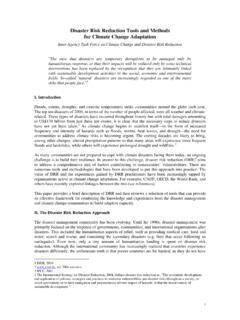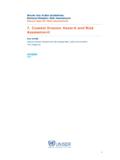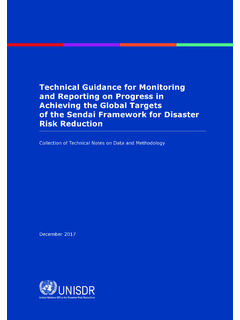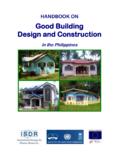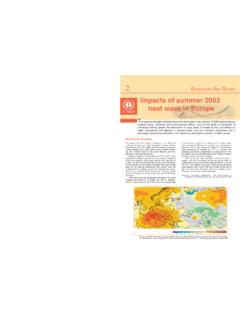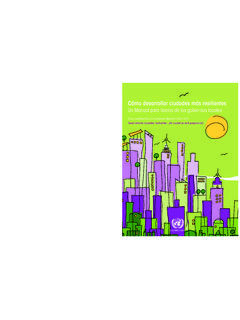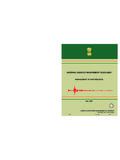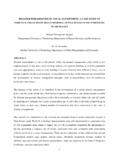Transcription of Progress and Challenges in Disaster Risk Reduction
1 2014A contribution towards the development of policy indicators for the Post-2015 Framework on Disaster Risk Reduction Progress and Challenges in Disaster Risk ReductionA contribution towards the development of policy indicators for the Post-2015 Framework on Disaster Risk Reduction Progress and Challenges in Disaster Risk Reduction United Nations 2014. All rights views expressed in this publication do not necessarily reflect the views of the United Nations Secretariat. The designations employed and the presentation of the material do not imply the expression of any opinion whatsoever on the part of the United Nations Secretariat concerning the legal status of any country, territory, city or area, or of its authorities, or concerning the delineation of its frontiers or (2014).
2 Progress and Challenges in Disaster Risk Reduction : A contribution towards the development of policy indicators for the Post- 2015 Framework on Disaster Risk Reduction . Geneva, Switzerland. The United Nations Office for Disaster Risk Reduction (UNISDR).This publication may be freely quoted but acknowledgment of the source is requested. This publication was developed with contributions from Kazuko Ishigaki (co-ordination and drafting), Vicente Anzellini (drafting), JoAnna Pollonais and David d Heilly (Editing). iiiIn many parts of our increasingly globalised world,processes such as badly planned and managed ur-ban development, environmental degradation, pov-erty and inequality and weak governance, are driv-ing levels of Disaster risk to new heights.
3 Given that our current approach to both public and private in-vestment tends to discount Disaster risk,the potential for future loss is enormous. This poses a critical threat to economic development, social welfare and environmental health. Since 2005, countries have been addressing thischallenge through the Hyogo Framework for Action(HFA), which aims to achieve a substantial reductionof Disaster losses, in lives and in the social, econom-ic and environmental assets of countries and com-munities by 2015. This publication aims at broaden-ing the understanding of how governments havebeen managing their Disaster risks in the context ofthe HFA. It does so by analyzing Progress Reportsprepared using the HFA Monitor, a multi-tier onlinetool for Progress review, facilitated by UNISDR andled by country ,therefore,increasesourknowledgeand understanding of how countries are addressingthe HFA, the Challenges and issues that govern-ments face and also the opportunities that risk management reduces uncertainty,builds confidence, cuts costs and creates value.
4 Thegrowing recognition of the value proposition of di-saster risk management needs now to be translatedinto a more systematic approach in the new Post2015 Framework for Disaster Risk Reduction that willbe adopted by UN Member States in Sendai, Japanin March publication presents timely guidance for thedevelopment of an enhanced set of policy indica-tors for Disaster risk management to underpin thePost 2015 Framework for Disaster Risk lessons learned in implementing the HFA are vi-tal to inform the collective efforts of governments,the private sector, civil society and other stakehold-ers to build the Disaster resilient communities andnations of the Wahlstr mSpecial Representative of the Secretary-Generalfor Disaster Risk ReductionForewordiiiIn many parts of our increasingly globalised world, processes such as badly planned and managed ur-ban development, environmental degradation, pov-erty and inequality and weak governance, are driv-ing levels of Disaster risk to new heights.
5 Given that our current approach to both public and private in-vestment tends to discount Disaster risk, the potential for future loss is enormous. This poses a critical threat to economic development, social welfare and environmental health. Since 2005, countries have been addressing this challenge through the Hyogo Framework for Action (HFA), which aims to achieve a substantial Reduction of Disaster losses, in lives and in the social, econom-ic and environmental assets of countries and com-munities by 2015. This publication aims at broaden-ing the understanding of how governments have been managing their Disaster risks in the context of the HFA. It does so by analyzing Progress Reports prepared using the HFA Monitor, a multi-tier online tool for Progress review, facilitated by UNISDR and led by country governments.
6 The publication, therefore, increases our knowledge and understanding of how countries are addressing the HFA, the Challenges and issues that govern-ments face and also the opportunities that present themselves. Disaster risk management reduces uncertainty, builds confidence, cuts costs and creates value. The growing recognition of the value proposition of di-saster risk management needs now to be translated into a more systematic approach in the new Post 2015 Framework for Disaster Risk Reduction that will be adopted by UN Member States in Sendai, Japan in March 2015. This publication presents timely guidance for the development of an enhanced set of policy indica-tors for Disaster risk management to underpin the Post 2015 Framework for Disaster Risk Reduction .
7 The lessons learned in implementing the HFA are vi-tal to inform the collective efforts of governments, the private sector, civil society and other stakehold-ers to build the Disaster resilient communities and nations of the future. Margareta Wahlstr mSpecial Representative of the Secretary-General for Disaster Risk ReductionForewordvivContentsForewordiiiI ntroductionxiiiChallenges and Progress regarding HFA core indicators 1 Priority 1: Ensure that Disaster risk Reduction is a national and a local priority with a strong institutional basis for implementation 3 Core indicator National policy and legal framework for Disaster risk Reduction exists with decentralized responsibilities and capacities at all levels4 Core indicator Dedicated and adequate resources are available to implement Disaster risk Reduction plans and activities at all administrative levels21 Core indicator Community participation and decentralization is ensured through the delegation of authority and resources to local levels28 Core indicator A national multi sectoral platform for DRR is functioning36 Priority 2.
8 Identify, assess and monitor Disaster risks and enhance early warning 51 Core indicator National and local risk assessments based on hazard data and vulnerability information are available and include risk assessments for key sectors52vCore indicator Systems are in place to monitor, archive and disseminate data on key hazards and vulnerabilities 66 Core indicator Early warning systems are in place for all major hazards, with outreach to communities 70 Core indicator National and local risk assessments take account of regional/trans-boundary risks , with a view to regional cooperation on risk Reduction 79 Priority 3: Use knowledge, innovation and education to build a culture of safety and resilience at all levels 87 Core indicator Relevant information on disasters is available and accessible at all levels, to all stakeholders (through networks, development of information sharing system etc.)
9 88 Core indicator School curricula, education material and relevant trainings include Disaster risk Reduction and recovery concepts and practices 89 Core indicator Research methods and tools for multi-risk assessments and cost benefit analysis are developed and strengthened 94 Core indicator Countrywide public awareness strategy exists to stimulate a culture of Disaster resilience, with outreach to urban and rural communities 99 Priority 4: Reduce the underlying risk factors 107 Core indicator Disaster risk Reduction is an integral objective of environment related policies and plans.
10 Including for land use natural resource management and adaptation to climate change 108 Core indicator Social development policies and plans are being implemented to reduce the vulnerability of populations most at risk 116 Core indicator Economic and productive sectoral policies and plans have been implemented to reduce the vulnerability of economic activities 119viCore indicator Planning and management of human settlements incorporate Disaster risk Reduction elements, including enforcement of building codes124 Core indicator Disaster risk Reduction measures are integrated into post Disaster recovery and rehabilitation process132 Core indicator Procedures are in place to assess the Disaster risk impacts of major development projects, especially infrastructure139 Priority 5.
